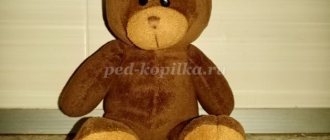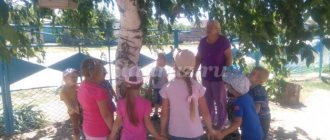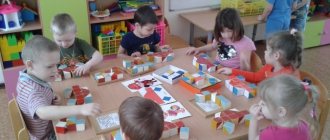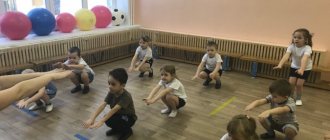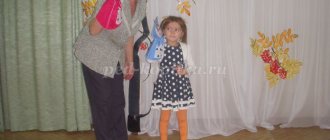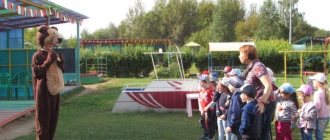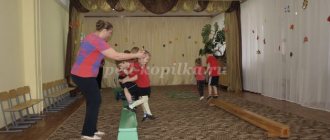Middle group. Junior preschool age. Children 4 - 5 years old
Abstract of an educational activity on introducing nature to the middle group “Excursion to the autumn forest” Purpose: To develop an ecological culture in preschool children . Objectives: -Introduce children to new safety rules. -To consolidate children’s knowledge about autumn changes in living and inanimate nature, to continue to develop children’s coherent speech. -Develop the ability to behave in nature, carefully...
Integration lesson in the middle group “Tour of your hometown. Mozdok" Integrated lesson in the middle group. Topic: “ Hometown tour ”
.
Goal: to expand children’s understanding of their hometown. Program objectives: Educational: clarify and consolidate children’s knowledge about the country, its name, hometown, form the concept of “Big”
and “Small...
Excursion to the spring park
— At home you should have picked up sayings about spring.
Winter scares spring, but it itself melts.
In the spring it bakes on top and freezes below.
Spring is red and hungry.
If you miss a day in the spring, you won’t get it back in a year
.
4.Collection of natural materials.
Collection of branches, fruits of deciduous trees and shrubs, cones of coniferous trees. Students collect natural materials. Once again we admire the variety of spring colors and feel like a part of the surrounding nature.
5. Game – competition “Recognize the tree by description”
— And now we’ll hold a game-competition “Recognize a tree by description” (
The teacher reads a description of the trees)
1. The Russian people fell in love with the white-trunked beauty. How many songs and poems have been written about her. This is one of the most beautiful trees in Russia. Its white trunk remains cold even on hot days. This tree produces up to 40 liters of sap before buds open. Furniture and plywood are made from it. The bark of this tree, birch bark, is ready-made natural paper. (Birch)
2. This tree is familiar to all of us since childhood. Not a single New Year's holiday is complete without it. It is green all year round, because... its needle leaf lives for 2-3 years, and the needles do not fall off all at once, but gradually, throughout the year. Birds love her. And the bear often builds its den under this tree. She lives up to 1200 years. (Spruce)
3. This tree grows not only in forests, but also in parks and gardens. It is often planted along the fences of houses so that it will delight people with its white lush inflorescences in the spring and fiery tassels in the fall. She lives up to 150 years. In early autumn, its berries are bitter-sour and hard. But as soon as the first frost catches them, they become tastier and softer. Jams and jams are made from the berries of this tree, and the honey from this tree is fragrant and healthy. (Rowan)
4. This tall, slender tree with a greenish-gray smooth trunk and a thick green crown decorates the squares and streets, squares and parks of our city. It perfectly cleans the air of dust and soot and releases more oxygen into the atmosphere than other trees. In spring, large buds swell on this tree. When the sticky shell falls from them to the ground, fragrant, shiny green leaves open. At the end of May, seed pods ripen on the tree. They burst and the fluff, caught by the wind, flies along the streets, as if covering the ground and trees with snow. (Poplar)
5. This tree is not picky about soil and can grow on sandy soils. It is photophilous. In the forest of these trees you can breathe easily. Wood grouse eat the needles of this tree; residential buildings are built from its logs, bridges and outbuildings are erected. The resin of this tree, which is collected by cutting the bark, is also valued. The juice of the pine needles and the infusion of the buds of this plant treat coughs and colds. Pine baths calm a person and strengthen his body. Amber was born from the resin of ancient representatives of this tree. (Pine)
Excursion in the fall in the middle group “Autumn changes in nature”
Summary of the autumn excursion in kindergarten in the middle group “Autumn changes in nature”
Age category of children: 4-5 years Goals and objectives: - observation of autumn changes in nature - develop observation, logical thinking, ability to compare - promote the development of cognitive interest - educate love and respect for nature
Excursion progress:
— Guys, what time of year is it now?
(Autumn) - Listen to a poem about autumn: Autumn has come, Our garden has turned yellow.
The leaves on the birch tree are burning golden. Do not hear the cheerful Songs of the nightingale. The birds flew away to distant lands. — What signs of autumn are listed there? (the leaves turned yellow, migratory birds flew away) - What other signs of autumn do you know? (It’s cold, it rains often, leaves fall from the trees) - Correct. Look at the sky, how gloomy it has become, how few leaves are left on the trees:
— Now we will take a walk around the area around the kindergarten and observe how nature has changed with the onset of autumn. - Here is our flowerbed. Do you remember how beautiful the flowers were here in the summer? There were a lot of flowers, we watered them and loosened them. Look what happened to them now? (They dried up, turned black, withered).
- Why do you think this happened? (They feel bad, it’s cold, there’s not enough sun) - Look, this is Rudbeckia, it froze when the snow fell:
- Now let's see what has changed in the garden? (The harvest was harvested, almost nothing remained in the beds, only weeds and fallen leaves). - Look, what kind of vegetable did I find in the garden? (carrot)
— Guys, look, how have the trees and shrubs changed? (The leaves have turned yellow, the leaves are falling, some are already without leaves)
“Are we really not going to see a single flower again?” There are flowers that are not as afraid of the cold as others. Look, there are still flowers left on Hydrangea:
- Now look here. What kind of tree is this? (Rowan) That's right, come closer, we'll take a look at it. What do we see on the branches of rowan? (Berries). - Who will be happy with these berries? (Birds) - That's right, the birds that stay with us for the winter.
“Can’t we find a single green tree with you?” (Let's find that the Christmas trees remain green) - That's right, almost all coniferous plants remain green. Let's take a closer look at the spruce. What are the needles on spruce trees called? (Needles) What can you say about spruce needles? (green, prickly, does not fall off in the winter)
Did you guys like our tour? (Yes) We will walk here again when the next season comes to observe how nature changes. What time of year will be after autumn? (Winter)
We recommend watching:
Summary of educational activities in the middle group with the use of ICT on the topic “Autumn” Summary of a speech therapy lesson in the middle group on the topic “Autumn” Autumn city tour for children Direct educational activities in the middle group of kindergarten on the topic: Autumn
Similar articles:
Synopsis of a sightseeing educational-ecological excursion in the middle group “Autumn Journey along the Ecological Trail”
Excursion to the spring park in May. Outline of a lesson on the world around us (middle group) on the topic
Summary of OOD in the middle group
Educational area - cognitive development
Excursion to the spring park in May.
Task:
- Introducing children to spring changes in nature in different periods: at the end of spring, the length of the day increases, the temperature rises, there are more sunny days, dandelions appear, leaves on trees and bushes, bird cherry blossoms, then lilacs, birds sing, bumblebees, butterflies appear, primroses, snowdrops.
- To develop the ability to establish connections between changes in inanimate nature and the life of plants and animals: it has become warmer - the earth has warmed up - plants are blooming - insects have appeared - birds have arrived.
- Develop the ability to compare dandelion and coltsfoot (from memory).
Integration of educational areas:
Speech development: Activate children's vocabulary: willow, maple, dandelion, anemone, nettle, lemongrass, bird cherry, lilac, ants, bumblebee, bee, chafer, nesting.
Social and communicative development: Cultivate curiosity, the desire to admire the beauty of spring nature, and treat it with care.
Preliminary work
Excursion to the spring park in April.
Progress of OOD
1 part. Preliminary conversation.
Educator: Guys, Pinocchio found out that we were going to the park today, and decided to ask us to bring the same white flower that we brought last time. Buratina really liked him. What is this flower called? (anemone). Do you think we can fulfill Buratino's request? (listen to suggestions).
— When were we in the park? What time of year? What was this period of spring called? (Mid-spring - revival).
— How can you find out whether the anemone is blooming in the park now or not? (Go and see).
- Who wants to know?
Part 2. Excursion progress:
Educator: Where have we come? To the park.
- What time of year is it? (Spring)
— How many months does spring last? Name them. (Three months: March, April, May).
Educator: Everything in nature wakes up in spring, why? (The sun is getting brighter every day, warming the earth.)
Educator: Name the signs of spring (spring sun, trees with buds, trees with young leaves, insects, birds flying from the south, animals molt, change color, breed).
Pinocchio: You are so great, you told everything so well about spring.
Educator: What has changed in the park after hibernation?
-What are the trees like? Shrubs? Why?
— Name familiar trees and shrubs? How did you know they were blooming?
—Has new grass appeared? How has she changed?
— What spring flowers have appeared? Do you find anemone among the flowers?
— What are the names of the flowers that appeared first from under the snow? (primroses, snowdrops). What other primroses do you remember (coltsfoot). Where did the snowdrops go? (bloomed).
- Which of the flowers that have appeared are similar to coltsfoot? (dandelion)
- How are they similar? How do they differ: in flowers, size, structure of the flower.
-What insects do you see?
— How did you recognize insects? What are they doing?
— Why do insects land on flowering plants? What insects have you noticed on the ground?
Watch the ants. What can you say about them? What are they doing?
Educator. Why should we protect ants?
- Why are there so many insects now?
- What migratory birds have arrived? Why?
- What are they doing now?
- What birds did you see?
- Why is the park beautiful now? (Everything blooms, especially bird cherry)
- What kind of plant is this? (lilac)
- When do you think the lilac will bloom? How did you guess?
Part 3. Pinocchio: What poems do you know about spring, about birds?
Educator: Guys, walk along the paths, look at the beauty of NATURE, listen to the birds singing.
Pinocchio: I enjoyed walking on a spring day so much that I wanted to draw a picture. Guys, can you help me?
Before leaving, you can dig up one dandelion and plant it in a flower pot.
